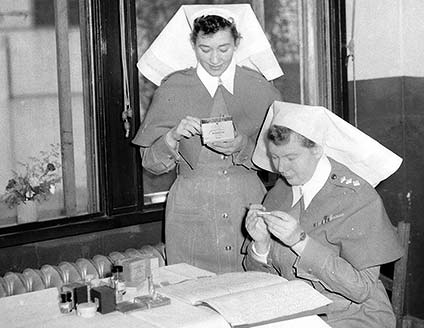The Support Base in Japan
Australian nurses at the British Commonwealth General Hospital at Kure
A total of one hundred and fifty-three Australian nurses served in Commonwealth hospital units during the Korean War...

Captain Perdita M. McCarthy of the Royal Australian Army Nursing Service (RAANS) is seated in a garden with a notebook or diary in her hands in the grounds of the British Commonwealth General Hospital at Kure. Captain McCarthy had been at Jacquinot Bay in Papua New Guinea in 1945 before serving with the British Commonwealth Occupation Force (BCOF) in Japan. She then served in the Korean War. Her long and distinguished career took her to the rank of Brigadier with the Royal Australian Army Nursing Corps. [AWM HOBJ0204] ... Enlarge the photo of Captain McCarthy
They tended to battle-casualties, health problems and the transportation of patients. Australian nurses, usually no more than 30 at any time, were based mainly in Japan but also served in Korea.
In Korea, nurses of the Royal Australian Air Force Nursing Service (RAAFNS) and the Royal Australian Army Nursing Service (RAANS) worked at the British Commonwealth Medical Zone Mobile Surgical Hospital in Seoul. Their task was to care for wounded and sick there. Apart from the wounded, nurses treated a wide variety of ailments brought on by the summer heat and harsh winters, remote mountain fighting and trench warfare. Trench foot, known in Korea as ‘rice-paddy feet’, incapacitated many front line troops and minor skin complaints could become serious in the prevailing conditions. The nurses placed a strong emphasis on patient’s personal hygiene and obtaining for them fresh food and water supplies.
A Medical Evacuation Unit staffed by the RAAFNS, prepared the patients for air transportation, and accompanied them on flights to Iwakuni in Japan. From 1950 to 1953, 12,762 Commonwealth wounded and sick flew this route. Based at Iwakuni, other nurses served in hospital trains taking the casualties on to the British Commonwealth General Hospital in Kure, where the majority of Australian nurses worked. No. 1 Ward there was entirely staffed by Australians. RAAFNS sisters also accompanied the 728 patients who were flown from Japan to Australia via Guam (or Manila) and Port Moresby.

Sister E. Dowling and Sister Ila Mary Smith, Royal Australian Air Force Nursing Service (RAAFNS) at work in Ward 1, the Australian-staffed ward of the British Commonwealth General Hospital in Kure, Japan. Photographer S. Baxter. [AWM 107821] ... Enlarge the photo of the nurses at work
The nurses were trained civilian nurses who joined the Australian Army and the Royal Australian Air Force for a four-year enlistment. All nursing personnel in Korea did rifle and pistol training because there was a fear that they may have to defend themselves if North Korean and Chinese troops did not respect the Red Cross or the Geneva Conventions.
The nurses in Korea were often placed in primitive and harsh conditions. Basic supplies like medicines, boots, socks and blankets were hard to acquire. Improvisation was essential to maintain even basic levels of sanitation and small elements of comfort. Nurses were required to assist with psychologically affected casualties for which they had had very little training.
Australian nurses served a one-year tour of duty in Korea or Japan. The last nurses departed in 1956.










